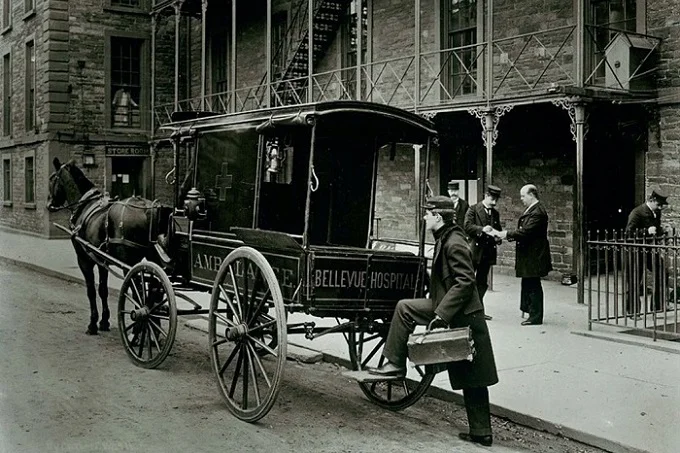Who invented ambulance service and how it changed: From Good Samaritan to European ambulances

Luke’s Gospel describes the parable of the good Samaritan who saved a Jew after being attacked by robbers, bandaging his wounds, pouring oil and wine on him, seated him on his donkey, and brought him to an inn where he took care of him. It is these lines that can be considered one of the first references to medical emergencies.
Nevertheless, it took another millennium and a half for mankind to make “emergency medicine” available to ordinary people. This article will discuss the emergence, decline, revival, and real breakthroughs of one of the most important services – the ambulance service.
War is the cause of everything
In the times of the first human civilizations, human life was not valued very highly. The only exceptions were rulers, the rich, and warriors. Soldiers in all armies tried to be treated, probably from the time when these armies began to appear.
Even in ancient antiquity, doctors practised seemingly gruesome bloody procedures. However, most of them did help save soldiers’ lives. And in some cases, they even brought experienced soldiers back into action. On the battlefields of antique battles, one of the first analogs of the now-familiar emergency medical service appeared.
The Roman order of field medicine
From the middle of the first century B.C., the Roman Empire’s army began to operate an organized medical care system, in many ways reminiscent of modern medicine. A wounded or sick soldier was taken to a “valetudinarium” (lat. Valetudinis, “health”). This institution was something in between an ambulance station and a military field hospital.
The staff of the Valetudinarii consisted of several dozen employees. Chief among them were surgeons and their assistants – capsaries. The latter were responsible for surgical instruments, dressings, and medical supplies, and wine supplies. In addition, Valetudinarian had their own transport, a centralized supply system, as well as “garden teams” for growing, collecting, and harvesting medicinal plants.
Each Valetudinarian, which was designed for several hundreds of beds, provided medical care to the soldiers of three legions. That’s about 15,000 soldiers and officers. Patients were brought to these “hospitals” by special brigades of 8-10 people who were stationed just behind the line of combat formations of legionaries.
To transport the wounded, they used raincoat hammocks, which were fixed between the horses. For anesthesia and pain relief, a special mixture of wine and intoxicating herbs was used, which was contained in the flasks of the “orderlies”. All of them received a cash bonus for each wounded legionnaire rescued.
The Romans made an invaluable contribution to the development of the first aid service. Subsequently, the valetudinarians received their own heating, water supply, and sewerage system. Separate operating rooms and dressing rooms were equipped, which were washed with hot wine to maintain “sterility”. All medical instruments were also processed.
All these achievements of civilization disappeared for several centuries after the fall of the Roman Empire in the 5th century A.D.
A Thousand Years Forgotten
It took humanity several centuries to only approach the level of medical care of the era of Ancient Rome. Something similar to the “ambulance” in Europe could be observed only at the beginning of the 15th century. However, now the ambulance has become available not only to the soldiers on the battlefield.
In the Netherlands, in 1417, a whole network of boat stations was founded, where doctors pumped out people who had drowned in river channels. In the same place, doctors warmed up the overcooled, and could, if necessary, bandage, make bloodletting, straighten a joint or bone.
In the 18th century, during the Age of Enlightenment, taking care of human health reaches a new level. Medical service is being organized in Paris. It worked like this: an inspector or police commissioner accompanied the doctor home to the patient.
If hospitalization was necessary, the guardian of order personally called a private “gig”, which delivered the patient to the monastery shelter. After that, the policeman handed out checks from the magistracy to the doctor and the driver.
“Father of the Ambulance”
It is believed that the French made the greatest contribution to the creation of a modern medical service. The surgeon Dominique Jean Larrey (1766-1842) is rightfully considered the “father of ambulance”. At the end of the 18th century, he organized mobile medical camps in the French army.
Larrey is the author of the idea of horse carts designed to evacuate the wounded from the battlefield, which he called “ambulance”. The Frenchman also designed mobile operating rooms – carriages drawn by four horses.

Dominique Jean Larrey developed and introduced triage tactics – medical “triage” of patients for lightly wounded, those who need urgent surgical care, infectious patients, and “hopeless” or dying.
During the Napoleonic campaign in Russia or the Egyptian campaign, despite the severity of the hostilities, the ambulances delivered the wounded to operations in just 10-20 minutes. This helped French medics save the lives of tens of thousands of soldiers and officers. In the legendary battle of Berezina, the “father of the ambulance” himself, Dominique Jean Larrey, personally performed 200 to 300 operations per day.
Breakthrough of the “ambulances” of the 19th century
The very first emergency medical services appeared in the second half of the 19th century in the United States – first at the Cincinnati Commercial Hospital (1865), and 4 years later at Bellevue Hospital (New York). New York doctors equipped their ambulances with everything necessary for the medical canons of the time: tires, stomach pumps, morphine, and a supply of brandy.

And yet, the real first ambulance station appeared on May 1, 1883, in Europe. It was organized in Vienna by Jaromir Mundi, a doctor, psychiatrist, and creator of military medical trains. The station had a control room with several parallel telephones, ambulance carriages, and substations for doctors.
Quite quickly, Mundi’s idea was implemented by the authorities of the Austro-Hungarian Empire. Ambulances equipped with two lamps began to ply in Vienna. One of which illuminated the road for the driver, and the other revolved, warning carriages and passers-by. This was the first ambulance flasher.
In addition to the network of ambulance stations, a stretcher was placed at every tram stop in Vienna. In total, there were 5 carriages and 11 ambulances in the capital of the Austro-Hungarian Empire. One of them was Jaromir Mundi himself, who worked 18-20 hours a day in different shifts – as a manager, orderly, doctor, and ambulance coachman. Vienna’s experience in setting up ambulance stations was soon picked up in other countries around the world.
Upgrading for civilization
General motorization of crews and ambulances, equipping them with defibrillators and oxygen devices, optimization of the dispatch service – the modernization of ambulances continued already in the 20th century.

Only in the second half of it did the ambulance finally acquire the look that is now familiar to everyone. Thus, the “medical luxury” of ancient warriors became generally available and quite commonplace for the majority of modern inhabitants of the Earth.
Human medicine has evolved and improved over the centuries. It isn’t easy to imagine how people lived without qualified help a few centuries ago, for example, the same dentists. And yet, historians know how the monarchs of different times treated their teeth.




